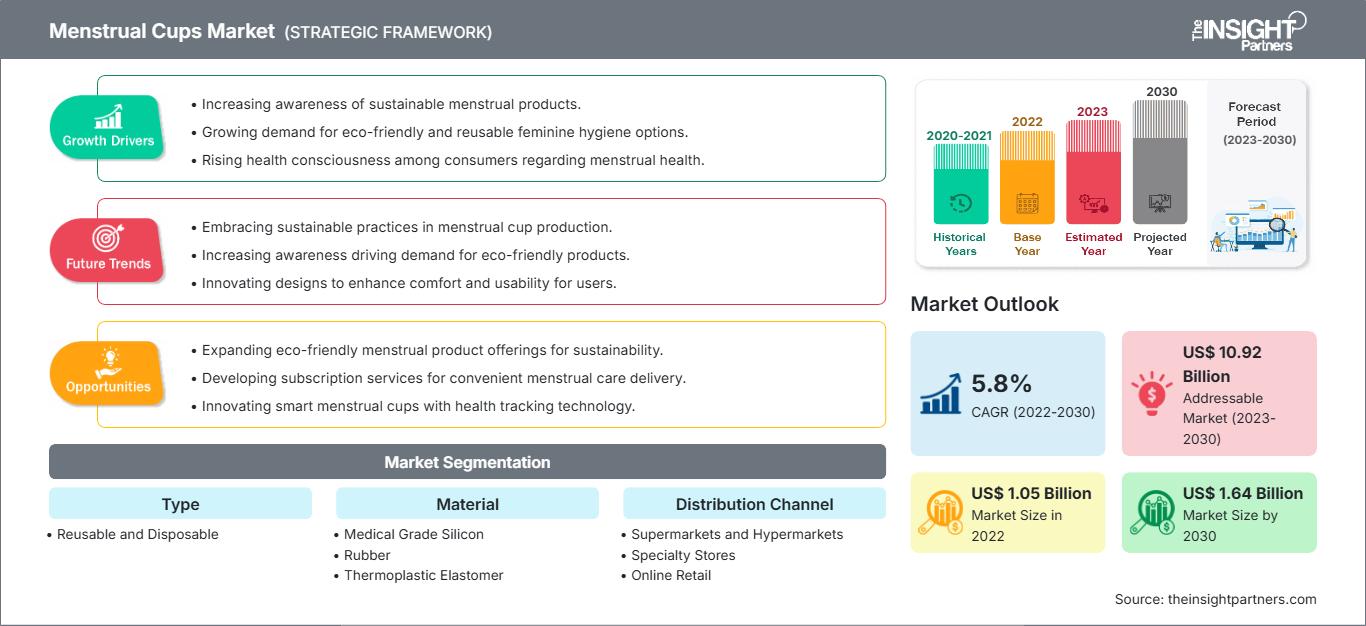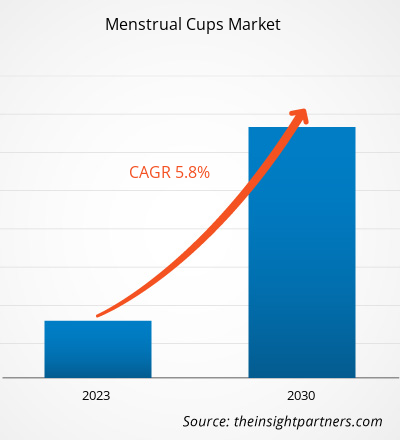[Informe de investigación] El tamaño del mercado de copas menstruales se valoró en 1.050,81 millones de dólares estadounidenses en 2022 y se espera que alcance los 1.644,06 millones de dólares estadounidenses para 2030; se estima que registrará una tasa de crecimiento anual compuesta (TCAC) del 5,8% desde 2022 hasta 2030.
Perspectivas del mercado y opinión de los analistas:
Las copas menstruales son dispositivos reutilizables en forma de campana diseñados para la higiene femenina durante la menstruación. Generalmente fabricadas con silicona o caucho de grado médico, estas copas se insertan en la vagina para recolectar el flujo menstrual en lugar de absorberlo como los tampones o compresas tradicionales. Crean un sello hermético para evitar fugas y pueden usarse hasta por 12 horas antes de necesitar ser vaciadas, ofreciendo una alternativa sostenible y económica a los productos desechables. Las copas menstruales están ganando popularidad por sus beneficios ambientales y el ahorro a largo plazo que representan en comparación con las opciones tradicionales de higiene menstrual.
Factores de crecimiento y desafíos:
La creciente demanda de productos menstruales sostenibles es uno de los principales factores que impulsan el mercado de las copas menstruales. En los últimos años, se ha producido un cambio global hacia la sostenibilidad, con consumidores cada vez más conscientes del impacto ambiental de los productos menstruales desechables tradicionales. Las compresas y tampones tradicionales contribuyen significativamente a la generación de residuos plásticos, y su producción implica el consumo de recursos y energía. Cada año, una mujer promedio desecha cerca de 150 kilogramos de residuos no biodegradables. Tan solo en India, aproximadamente 121 millones de mujeres y niñas utilizan un promedio de ocho compresas desechables y no compostables al mes, generando 1.021 millones de compresas desechadas mensualmente, 12.300 millones de compresas desechadas anualmente y 113.000 toneladas métricas de residuos menstruales al año. Las copas menstruales se han consolidado como una opción preferida para quienes buscan alternativas ecológicas gracias a su reutilización. Esta mayor conciencia ambiental impulsa a los consumidores a optar por productos que minimicen su huella ecológica, lo que a su vez aumenta la demanda de copas menstruales.
La creciente demanda de productos menstruales sostenibles está estrechamente ligada a un movimiento más amplio que aboga por la salud y el bienestar de las mujeres. Las consumidoras priorizan cada vez más los productos que no solo son respetuosos con el medio ambiente, sino también seguros y beneficiosos para su salud. Las copas menstruales, generalmente fabricadas con silicona, caucho o elastómeros termoplásticos de grado médico, se consideran seguras e higiénicas, lo que reduce el riesgo de irritación y reacciones alérgicas que suelen asociarse a los productos tradicionales. La congruencia entre las copas menstruales, la sostenibilidad ambiental y la salud femenina contribuye a su atractivo, impulsando así su creciente popularidad.
Obtendrá personalización gratuita de cualquier informe, incluyendo partes de este informe, análisis a nivel de país y paquetes de datos de Excel. Además, podrá aprovechar excelentes ofertas y descuentos para empresas emergentes y universidades.
Mercado de copas menstruales: Perspectivas estratégicas

-
Obtenga las principales tendencias clave del mercado que se describen en este informe.Esta muestra GRATUITA incluirá análisis de datos, que abarcarán desde tendencias de mercado hasta estimaciones y pronósticos.
La demanda de productos menstruales sostenibles se ha visto impulsada por diversos grupos de defensa, ONG e iniciativas gubernamentales que buscan concienciar sobre el impacto ambiental de las opciones desechables. Las campañas que promueven la menstruación sostenible han sido cruciales para informar al público sobre los beneficios de alternativas reutilizables como la copa menstrual. La creciente visibilidad y el respaldo a las prácticas menstruales sostenibles contribuyen a un cambio positivo en la actitud de las consumidoras, fomentando una mayor aceptación y adopción de la copa menstrual.
La demanda de productos menstruales sostenibles también se ve impulsada por una generación más joven de consumidores que priorizan las opciones ecológicas. Los millennials y la Generación Z, en particular, impulsan la demanda de productos sostenibles y éticos en diversos sectores, incluido el cuidado personal. La conciencia y las preferencias de estos grupos demográficos influyen en las tendencias del mercado, y las copas menstruales, al ser una opción sostenible e innovadora, se alinean perfectamente con sus valores. A medida que este grupo demográfico siga aumentando su poder adquisitivo, la demanda de copas menstruales también crecerá, reforzando su posición en el mercado como un producto menstrual sostenible líder.
Sin embargo, la percepción y el desconocimiento de las consumidoras representan importantes obstáculos en el mercado de las copas menstruales, lo que repercute en su adopción a nivel mundial. Muchas personas desconocen los beneficios de las copas menstruales debido a la falta de educación integral y campañas de sensibilización. El desconocimiento del producto y sus ventajas, como su rentabilidad, su menor impacto ambiental y su mayor tiempo de uso, contribuye a la reticencia de las usuarias potenciales a abandonar los productos menstruales tradicionales. Esta falta de información puede generar ideas erróneas e inhibiciones, lo que dificulta la aceptación generalizada de las copas menstruales como una alternativa viable y práctica.
La reticencia a usar copas menstruales suele deberse a la preocupación por la dificultad de inserción y extracción. Muchas usuarias perciben la curva de aprendizaje como una barrera, asumiendo que requiere cierta habilidad o comodidad que tal vez no posean. El desconocimiento sobre la sencilla aplicación de las copas menstruales y sus posibles beneficios para la salud contribuye a esta aprensión. Para superar estas ideas preconcebidas y conceptos erróneos, se requieren iniciativas educativas específicas que destaquen la facilidad de uso, la comodidad y el impacto ambiental positivo de las copas menstruales. Al abordar estas preocupaciones y fomentar la concientización, el mercado puede contribuir a desmitificar las ideas erróneas y promover una percepción más positiva de las copas menstruales entre las usuarias potenciales.
Segmentación y alcance del informe:
El mercado global de copas menstruales se segmenta según el tipo, el material, el canal de distribución y la geografía. Por tipo, se divide en reutilizables y desechables. Por material, se clasifica en silicona de grado médico, caucho y elastómero termoplástico. Por canal de distribución, se clasifica en supermercados e hipermercados, tiendas especializadas, venta online y otros. Geográficamente, el mercado global de copas menstruales se segmenta en Norteamérica, Europa, Asia Pacífico, Oriente Medio y África, y Sudamérica y Centroamérica.
Análisis segmentario:
Según su tipo, el mercado de copas menstruales se divide en reutilizables y desechables. Se prevé que el segmento de copas reutilizables registre la mayor tasa de crecimiento anual compuesto (CAGR) entre 2022 y 2030. Las copas menstruales reutilizables representan una revolución sostenible y rentable en la higiene menstrual. Fabricadas generalmente con silicona, caucho o elastómeros termoplásticos de grado médico, estas copas en forma de campana se insertan en la vagina para recoger el flujo menstrual en lugar de absorberlo como los tampones o compresas tradicionales. La flexibilidad y suavidad del material garantizan comodidad y facilidad de uso, adaptándose a la anatomía de la usuaria. Las copas menstruales reutilizables se pueden usar hasta por 12 horas, brindando protección contra fugas y permitiendo una mayor flexibilidad en la gestión del ciclo menstrual. Una de sus ventajas más significativas es su impacto ambiental, ya que se pueden reutilizar. Las copas reducen significativamente la cantidad de residuos menstruales, contribuyendo a una rutina de cuidado menstrual ecológica. Además, el ahorro a largo plazo y la comodidad de no tener que comprar productos desechables con regularidad hacen de las copas menstruales reutilizables una opción cada vez más popular para las usuarias que buscan alternativas sostenibles y prácticas para la higiene menstrual.
Análisis regional:
El mercado de copas menstruales se segmenta en cinco regiones clave: Norteamérica, Europa, Asia Pacífico, Sudamérica y Centroamérica, y Oriente Medio y África. Norteamérica dominó el mercado mundial de copas menstruales en 2022, con un valor de 395,41 millones de dólares estadounidenses. Europa es el segundo mayor contribuyente, con más del 30 % del mercado global. Se prevé que Asia Pacífico registre una tasa de crecimiento anual compuesta (TCAC) considerable, superior al 5 %, durante el período 2022-2030. El aumento de la demanda de copas menstruales en Asia Pacífico se puede atribuir a diversos factores, como los cambios culturales, la creciente concienciación y la importancia cada vez mayor de la salud femenina. En muchos países asiáticos se observa un movimiento creciente para romper los tabúes en torno a la menstruación.
Impacto de la pandemia de COVID-19:
La pandemia de COVID-19 inicialmente obstaculizó el mercado mundial de copas menstruales debido al cierre de plantas de producción, la escasez de mano de obra, la interrupción de las cadenas de suministro y la inestabilidad financiera. La interrupción de las operaciones en diversas industrias, causada por la desaceleración económica derivada del brote de COVID-19, restringió el suministro de copas menstruales. Además, el cierre de numerosos comercios limitó sus ventas. Sin embargo, las empresas comenzaron a recuperarse a medida que se levantaron las restricciones impuestas en varios países en 2021. Asimismo, la implementación de campañas de vacunación contra la COVID-19 por parte de los gobiernos de diferentes países alivió la situación, lo que impulsó un aumento de la actividad comercial a nivel mundial. Varios mercados, incluido el de copas menstruales, registraron crecimiento tras la flexibilización de las medidas de confinamiento y las restricciones de movilidad.
Perspectivas regionales del mercado de copas menstruales
Los analistas de The Insight Partners han explicado en detalle las tendencias regionales y los factores que influyen en el mercado de copas menstruales durante el período de previsión. Esta sección también analiza los segmentos de mercado y la geografía del mercado de copas menstruales en Norteamérica, Europa, Asia Pacífico, Oriente Medio y África, y Sudamérica y Centroamérica.
Alcance del informe de mercado de copas menstruales
| Atributo del informe | Detalles |
|---|---|
| Tamaño del mercado en 2022 | 1.050 millones de dólares estadounidenses |
| Tamaño del mercado para 2030 | 1.640 millones de dólares estadounidenses |
| Tasa de crecimiento anual compuesto global (2022 - 2030) | 5,8% |
| Datos históricos | 2020-2021 |
| período de previsión | 2023-2030 |
| Segmentos cubiertos |
Por tipo
|
| Regiones y países cubiertos |
América del norte
|
| Líderes del mercado y perfiles de empresas clave |
|
Densidad de actores del mercado de copas menstruales: comprensión de su impacto en la dinámica empresarial
El mercado de copas menstruales está creciendo rápidamente, impulsado por la creciente demanda de las usuarias finales debido a factores como la evolución de las preferencias de las consumidoras, los avances tecnológicos y una mayor conciencia de los beneficios del producto. A medida que aumenta la demanda, las empresas amplían su oferta, innovan para satisfacer las necesidades de las consumidoras y aprovechan las nuevas tendencias, lo que impulsa aún más el crecimiento del mercado.

- Obtén una visión general de los principales actores del mercado de copas menstruales.
Panorama competitivo y empresas clave:
Nixit, Lunette Global, Lena Cup LLC, Diva International Inc., Saalt, Pixie Cup, June Cup, Cora, The Flex Company y Blossom Cup se encuentran entre los principales actores que operan en el mercado mundial de copas menstruales.
- Análisis histórico (2 años), año base, pronóstico (7 años) con CAGR
- Análisis PEST y FODA
- Tamaño del mercado, valor/volumen: global, regional y nacional
- Industria y panorama competitivo
- Conjunto de datos de Excel
Informes recientes
Testimonios
Razón para comprar
- Toma de decisiones informada
- Comprensión de la dinámica del mercado
- Análisis competitivo
- Información sobre clientes
- Pronósticos del mercado
- Mitigación de riesgos
- Planificación estratégica
- Justificación de la inversión
- Identificación de mercados emergentes
- Mejora de las estrategias de marketing
- Impulso de la eficiencia operativa
- Alineación con las tendencias regulatorias






















 Obtenga una muestra gratuita para - Mercado de copas menstruales
Obtenga una muestra gratuita para - Mercado de copas menstruales